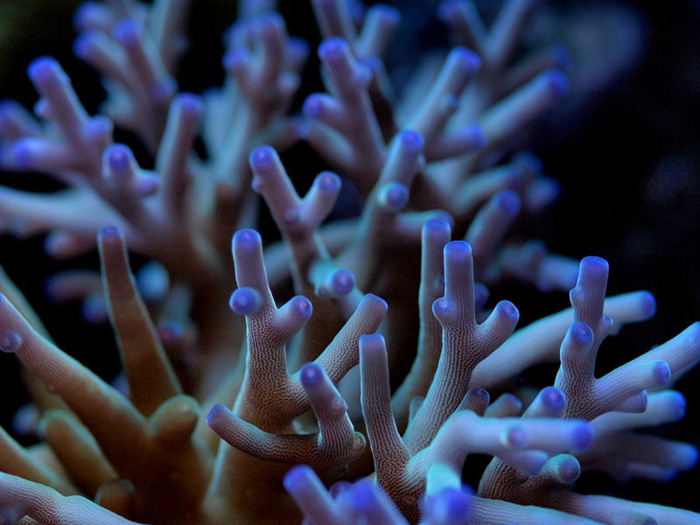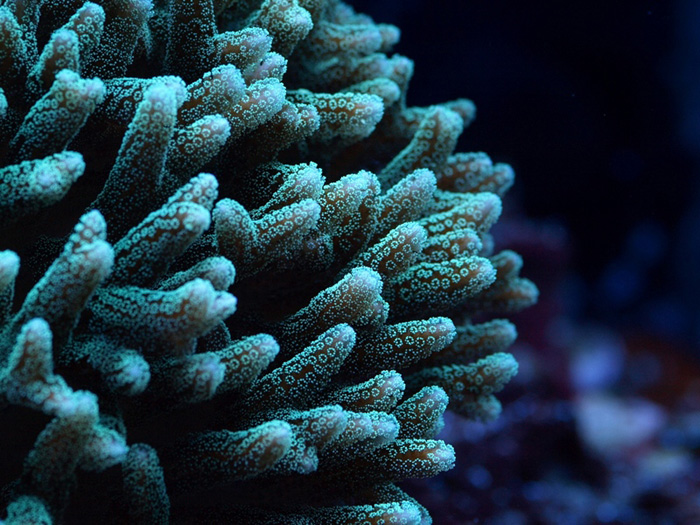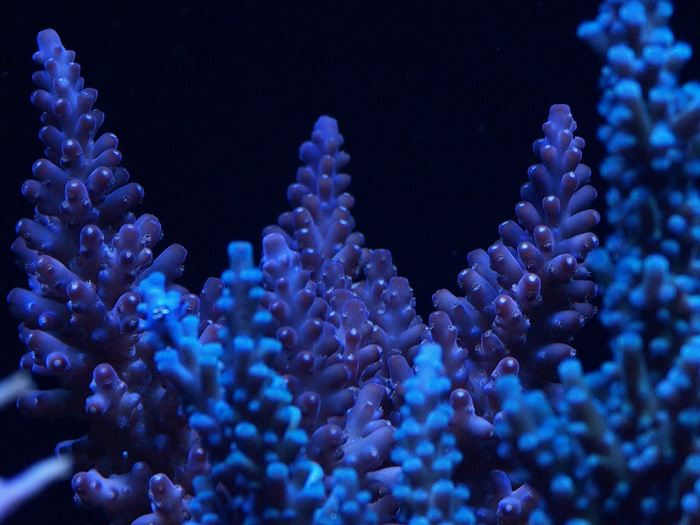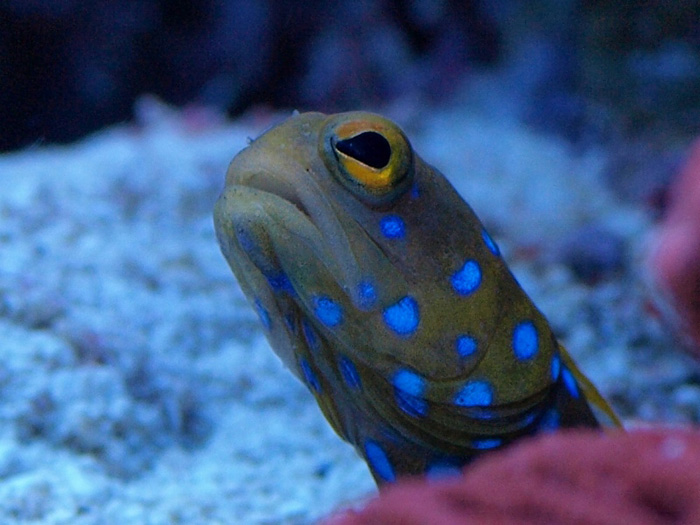By Keith Berkelhamer
 Too bad keeping a thriving SPS tank isn’t as simple as making scrambled eggs. According to a recipe I came across, “perfect” scrambled eggs for two require 6 large eggs, 6 teaspoons low-fat milk, 3 dashes of salt, and 1 tablespoon butter for frying. I don’t claim to have all the ingredients to maintain a “perfect” SPS tank, but I’ve had enough success during my 15 years in the hobby to pass along some helpful tips.
Too bad keeping a thriving SPS tank isn’t as simple as making scrambled eggs. According to a recipe I came across, “perfect” scrambled eggs for two require 6 large eggs, 6 teaspoons low-fat milk, 3 dashes of salt, and 1 tablespoon butter for frying. I don’t claim to have all the ingredients to maintain a “perfect” SPS tank, but I’ve had enough success during my 15 years in the hobby to pass along some helpful tips.
A Key Ingredient: Knowledge
When I first started keeping SPS I did a lot of research and talked with LFS owners and reefers who had tanks I admired. The Internet was in its infancy, so doing research via message boards was not really an option—a major disadvantage given the wealth of information these forums yield today. I soaked up as much information as I could and started a reef with some common and hardy SPS.
I certainly made my share of mistakes, a normal thing for a noob who was still learning on the job. I learned from these mistakes and fine tuned my approach for my current 225 gallon SPS dominated tank, which I started about two and a half years ago.
And I am still learning today. This challenging hobby demands it.
Calcium & Alkalinity
Calcium & alkalinity supplementation is perhaps the most important ingredient. I run a calcium reactor and it does a fantastic job sustaining calcium and alkalinity levels. I also use a kalkwasser (limewater) reactor to boost the low pH produced by the calcium reactor and for additional calcium and alkalinity supplementation. These two pieces of equipment are the first things I check when my SPS don’t look right.
I test my alkalinity on a weekly basis to make sure things don’t stray. I also test weekly for calcium, but keeping my dkh in the 8-10 dkh range is an absolute must for my tank. I have experienced faded colors and even some bleaching at the base of certain SPS when the dkh strays into the 7 range.
Another key ingredient is lighting. I use three 20k 400W Radium metal halide bulbs over my 72”L X 30”W X 24”T tank. The Radiums are driven by Sunlight Supply Blue Wave 7 HQI ballasts, which overdrive the bulbs and provide more punch than non-HQI ballasts. They also produce a nice crisp white look and not the bluish hue you normally get from many 20k bulbs. I truly believe my strong SPS growth and vivid colors are due in large part to this bulb and ballast combo. I do have to change out my Radiums every six months since they are overdriven and this is certainly a negative given the high price of bulbs. Rounding out my lighting setup are eight 39W POWERCHROME Actinic Plus T5 bulbs from Giesemann.
High Import/Export
High import and export of nutrients is also a key ingredient to my success. I do weekly water changes of just under 15% so I am changing out approximately 60% of my water every month. I also skim heavily. As for the import part, I have a lot of fish that are fed twice daily so my corals benefit from the nutrients in the liberal portions of food I supply. The main feeding consists of two cubes of frozen Mysis shrimp and one Spirulina Brine cube while pellets are used for the second feeding. Elements within the “poop” produced by the fish provide extra nutrition to my SPS and other corals. Cyclopeeze, Tropic Marin Pro-Coral Zooton and Reef Nutrition’s Roti Feast and Oyster Feast are added daily and give the corals additional nourishment. Kent Marine Lugol’s solution is dosed once a week.
Every tank differs, so it does take time to find that balance between removing the right amount of waste and feeding the tank. I advocate keeping a slightly “dirty” tank (slightly detectable nitrates and phosphates) vs. one that is sterile (0 nitrates and phosphates) so being a bit heavier on the import side seems to work for me. Faded, less colorful corals can be an indication that corals are starving from too much nutrient export.
I also utilize a carbon reactor to keep my water crystal clear and a phosphate reactor to keep nuisance algae in check.
Flow is another key component. I don’t advocate blasting the tank, but you need to keep things moving to minimize the build-up of detritus and deliver nutrients to corals. Flow comes from two main sources: two Blueline 70 return pumps and two tunze 6200s with a Tunze 7095 multicontroller. The tunze pumps are positioned in the back corners facing one another along the back panel. This was part of my original tank design to have an open channel in the back of the tank to allow for more circulation. A controller has the tunze pumps operating on different intervals to create a nice random surge within the tank. An Ecotech Marine MP40 pump was added about six months ago for more flow, a necessity due to all the coral growth that began to negatively impact flow throughout the tank.
Stability
I have learned many things while keeping reefs, but near the top of my list is striving to keep things stable. I personally have a hard time with change and corals are the same way. “Stable” is defined in the dictionary as “firmly established, fixed, steadfast, not changing or fluctuating, unvarying, permanent, enduring”. For reef keeping, this text book definition applies to such parameters as salinity, nitrate, magnesium, and calcium. And perhaps most important in my book for SPS is keeping alkalinity at a consistent level. Earlier I mentioned that my tank is happiest when alkalinity is in a certain range, but doing so on a consistent, stable basis is just as important. I do everything I can to keep this parameter rock solid and not let it swing significantly over a short period of time.
Of course the text book definition for “stability” has to be tweaked for certain reef keeping parameters since we are seeking to “maintain established patterns” and trying to “replicate a sequence of variability”. For instance, temperature and pH in our natural reefs around the world vary depending on the time of day so consistently mimicking these patterns in our reef tanks is very important.
 Recently, I witnessed firsthand how corals can be damaged when a pattern of stability is disrupted. I was away on vacation for nine straight days and had a few people lined up to watch and feed the tank. One of those folks was the wife, who should be sainted for putting up with my reef keeping obsession. Anyway, she was supposed to hit the feed button on my vortech pump, but mistakenly hit a button on the light timer that operates two of the three Radiums. They ended up running for five straight days!
Recently, I witnessed firsthand how corals can be damaged when a pattern of stability is disrupted. I was away on vacation for nine straight days and had a few people lined up to watch and feed the tank. One of those folks was the wife, who should be sainted for putting up with my reef keeping obsession. Anyway, she was supposed to hit the feed button on my vortech pump, but mistakenly hit a button on the light timer that operates two of the three Radiums. They ended up running for five straight days!
I should have realized what was going on since I was eyeballing the temperature remotely via software from my neptune AquaController. Why, I asked myself, was the temperature not following its normal ups and downs during the day and night? I surmised we left the heat on and decided not to worry. I was also monitoring the tank with my dedicated web cam and all seemed fine.
When I got home it was obvious something was wrong. Several of my SPS colonies had lost some color and appeared burned. Even my prized Black Tang didn’t look right with white patches and what appeared to be scratches on its body. It was stress from five straight days of no sleep!
This is a dramatic example of what can happen when stability gets out of whack, but I am happy to report the Black Tang and corals have made significant recoveries since the mishap. Note to self: In the future, look at the web cam when the lights are supposed to be off to make sure they are indeed off!
When I first started in this hobby I couldn’t keep my hands out of the tank. I was constantly moving things around in my quest to achieve the “perfect” look. All the rearranging was stressing out the corals and impeding their growth. I also believe the oils from my skin were having a negative impact. Now I don’t obsess over coral placement and the natural look I’ve achieved with my current tank is a result of this practice. Be patient and keep those hands out of the tank when the urge to fiddle strikes.
It is also important to not over-react and create unnecessary stress when the reef keeping gods throw you a curveball. A couple of years ago I discovered Acro Eating Flat Worms (AEFW) in my tank. I did some research on the topic and found that many reefers removed all their Acros and dipped them in a medicated solution to eradicate these nasty pests. This might be ok for a new tank but I think it can do more harm than good for a more established tank. I took a more natural path and used a turkey baster to blow off the worms.
Some of my fish got in on the routine and followed the baster, scoring an opportunistic meal. Today I still have a few of the buggers around but they really don’t have a negative impact on the reef. I still baste on a weekly basis to keep them in check, but not ripping apart the reef was less taxing and ultimately the right path for my system.
Maintenance
Last but not least on my list of ingredients is maintenance. I can’t stress how important it is to have a regular routine to keep on top of those water changes, check parameters, and perform any necessary maintenance on equipment. Keeping and maintaining SPS in a reef is a lot of work, but putting the necessary time in can reap substantial rewards.
So that’s my recipe. I hope you don’t take it with a grain of salt.





0 Comments